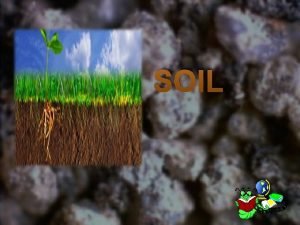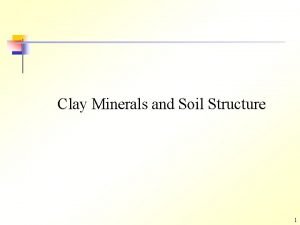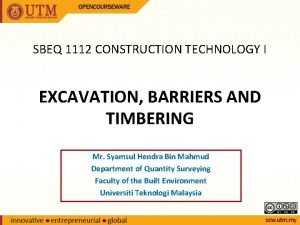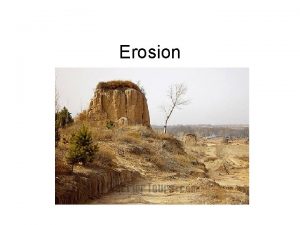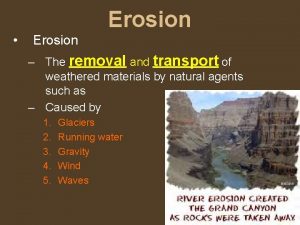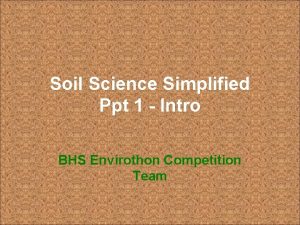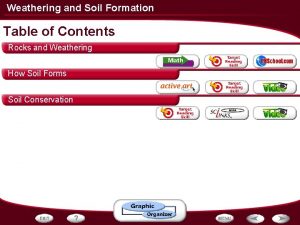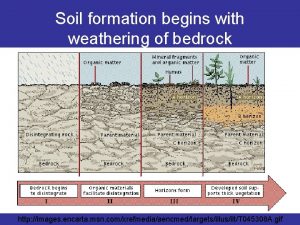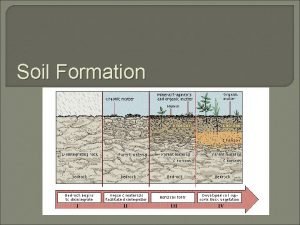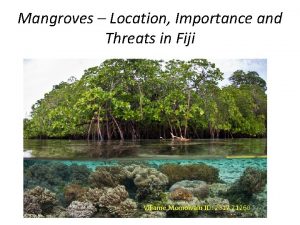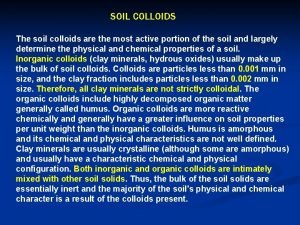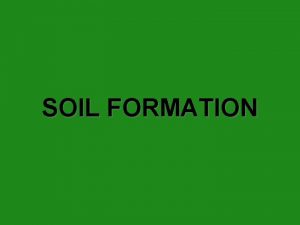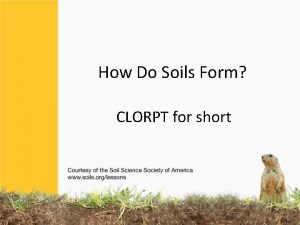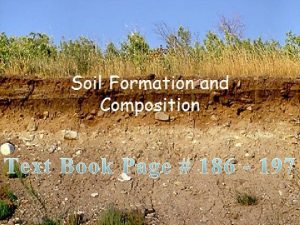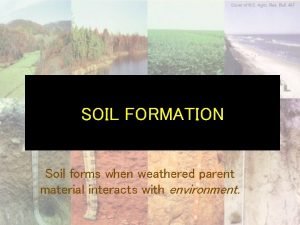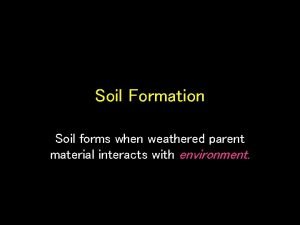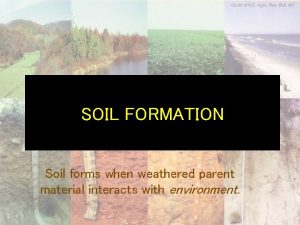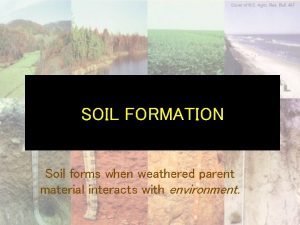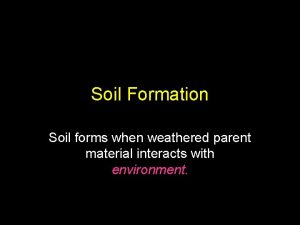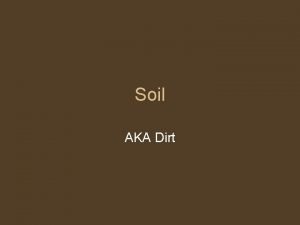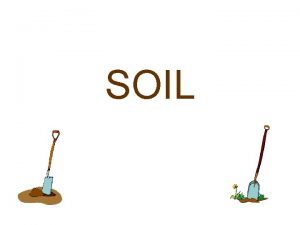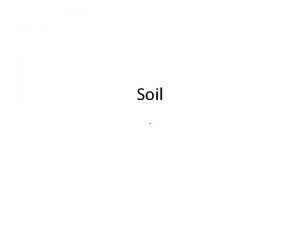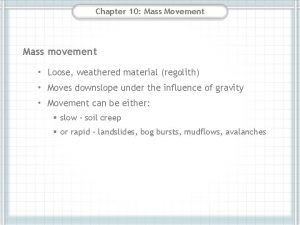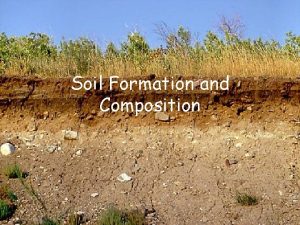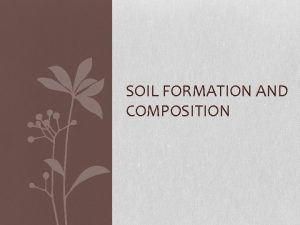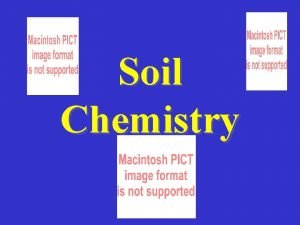Soil Formation Soil The loose weathered material on



















- Slides: 19

Soil Formation Soil – The loose, weathered material on Earth’s surface in which plants can grow. How is soil formed? 1. Mechanical and chemical weathering breaks rocks into very fine sediments. 2. These sediments mixes with other materials on the surface to form soil. How long does it take to form soil? Soil formation occurs over a long period of time Bedrock – The solid layer of rock beneath the soil. It gradually weathers into soil whenever it is exposed.

Soil Composition and Texture Soil is a mixture of rock particles, minerals, decayed organic material, air, and water. • Humus – Dark colored; decayed organic material in soil; helps create spaces in soil for air and water; rich in elements that plants need • Loam – soil made up of about equal parts of clay, sand, and silt; ideal for most plants

Soil Particle Size

Soil Profile – The entire collection of soil horizons. Soil horizon – Layer of soil that differs in color and texture from layers above or below it. Soil (Review) rock and 1. Soil is a combination of Weathered _______ Organic matter _________. 2. ______ = decayed plant and animal Humus material found in soil. Soil that contains 20 -30% humus is considered a rich soil for plant growth.

4. Soil layers- The soil profile Topsoil Horizon = ______ or A ______ the top layer of soil that contains more humus than the layers below. Sub soil or ______ B Horizon = ______ consists of clays and dissolved minerals that have been washed down from above. Contains less humus. C Horizon = consists of ______ weathered rock fragments, usually from the parent rock below. Bedrock = the layer of rock ______ beneath the soil. Frequently the parent rock of the soil above.


Soil development 1. The C horizon forms as bedrock weathers and rock breaks up into soil particles 2. The A horizon develops as plants add organic material to the soil and plant roots weather pieces of rock. 3. The B horizon develops as rainwater washes clay and minerals from the A horizon to the B horizon.

Soil Types Georgia’s soil is Southern Forest soil – form in wet and warm climate; low in humus. Scientists classify the different types of soil into major groups based on climate, plants, and soil composition.

Living Organisms in soil


Importance of Living organisms in Soil • Some soil organisms, like earthworms, mix the soil and make spaces in it for air and water. • Other soil organisms make humus, which makes soil fertile.

Forming Humus Litter – The loose layer of dead plant leaves and stems on the surface of soil. Decomposers – Soil organisms that breaks down the remains of dead plants and organisms and digest them.

Soil Conservation • Soil is one of Earth’s most valuable natural resources because everything that lives on the land depends directly or indirectly on soil. • Fertile soil is valuable because there is a limited supply. – Less than 1/8 th of the land on Earth has soils well suited for farming. – US Department of Agriculture estimates that it takes 500 years to form an inch of topsoil. That is less than 0. 01 mm/year.

Soil Damage and Loss 1. Loosing fertility - Soil can become exhausted, or lose its fertility. 2. Erosion - Soil can also become lost to erosion by water and wind. – Water erosion can occur wherever soil is not protected by plant cover. – Wind erosion caused the Great Dust Bowl!! Sod – The thick mass of tough roots at the surface of soil keep the soil in place and hold onto moisture; found in prairies

The Dust Bowl – Loss of Topsoil • In the 1930 s plowing removed the grass form the Great Plains and exposed the soil. In times of drought, the topsoil quickly dried out, turned to dust, and blew away. • This event helped people appreciate the value of soil. • Check It Out!!

How to help in Soil Conservation? • Soil Conservation is the management of soil to prevent its destruction. • Three ways that soil can be conserved include contour plowing, conservation plowing, and crop rotation.

Contour Plowing • Contour plowing is the practice of plowing fields along the contours of a slope. • This helps slow the runoff of excess rainfall and prevents it from washing the soil away.

Conservation Plowing • Conservation Plowing disturbs the soil and its plant cover as little as possible. • Dead weeds and stalks of the previous year’s crop are left in the ground to help return soil nutrients.

Farmers plants different crops each year Different type of crops absorb different types of nutrients from soil
 Loose weathered rock and organic material
Loose weathered rock and organic material Soil is a mixture of weathered rock and ________.
Soil is a mixture of weathered rock and ________. Relative density of loose soil
Relative density of loose soil Timbering in loose soil
Timbering in loose soil Soil is a loose mixture of
Soil is a loose mixture of Rhyme scheme o captain my captain
Rhyme scheme o captain my captain The process by which natural forces move weathered
The process by which natural forces move weathered Materials transported due to erosion
Materials transported due to erosion Formation initiale vs formation continue
Formation initiale vs formation continue Soil science ppt topics
Soil science ppt topics Stages of soil development
Stages of soil development Soil formation begins with weathering of
Soil formation begins with weathering of Soil profile
Soil profile Talk dirty
Talk dirty White mangrove
White mangrove Formation of soil
Formation of soil Colloids are important to soil formation because
Colloids are important to soil formation because Soil textural triangle practice exercises
Soil textural triangle practice exercises How do soils form
How do soils form Soil
Soil
